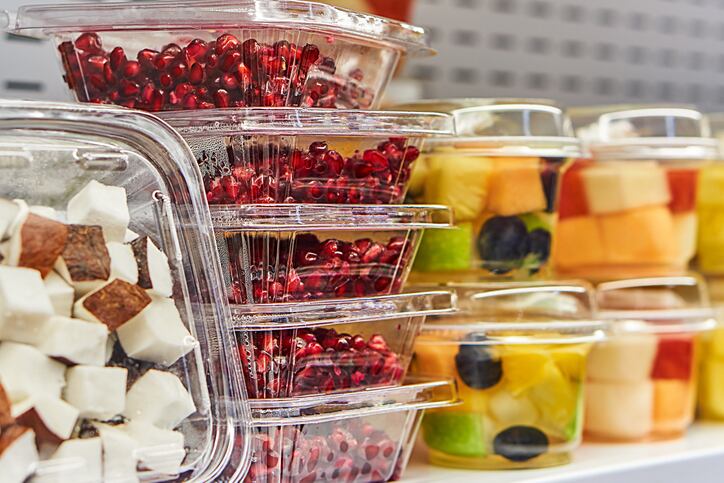Every year, more than 350 million tonnes of plastic – much of it used by the food industry – is produced worldwide. According to researchers at the ETH Zürich university in Switzerland, these plastics contain a huge variety of chemicals that may be released during their lifecycles -- including substances that pose a significant risk to people and the environment. However, only a small proportion of the chemicals contained in plastic are publicly known or have been extensively studied.
A team of ETH researchers claims to have for the first time compiled a comprehensive database of plastic monomers, additives and processing aids for use in the production and processing of plastics on the world market, and systematically categorized them on the basis of usage patterns and hazard potential.
The team identified around 10,500 chemicals in plastic: 2,109 were used in food-contact applications; in packaging (2,489), textiles (2,429); some are for toys (522) and medical devices, including masks (247).
Of the 10,500 substances identified, the researchers categorized 2,480 substances (24%) as substances of potential concern. Amoung food-contact applications, 679 are substances of potential concern.
Of of the 679 substances of potential concern amoung food-contact applications, the study revelealed there are:
- 528 high-production volume chemicals, 434 not regulated chemicals, and 52 chemicals without any scientific references.
- 9 are persistent and bioaccumulative, 120 are carcinogenic, 51 are mutagenic, 132 are toxic for reproduction, 300 are toxic for specific target organs, 404 are toxic for aquatic organisms, and 22 are endocrine disrupting
- 119 substances of unknown or variable composition (UVCBs), 131 contain metals, 507 are (partially) organic, 13 contain silicon, 23 contain phosphor, 77 contain sulfur, and 92 contain halogens (like bromine, chlorine, fluorine, etc.)
Of the 2,109 chemicals that are used, there are:
- 513 substances of unknown or variable composition (UVCBs), 402 contain metals, 1682 are (partially) organic, 69 contain silicon, 90 contain phosphor, 226 contain sulfur, and 214 contain halogens (like bromine, chlorine, fluorine, etc.)
"This means that almost a quarter of all the chemicals used in plastic are either highly stable, accumulate in organisms or are toxic. These substances are often toxic to aquatic life, cause cancer or damage specific organs," said Helene Wiesinger, doctoral student at the Chair of Ecological Systems Design and lead author of the study. About half are chemicals with high production volumes in the EU or the US, she said.
"It is particularly striking that many of the questionable substances are barely regulated or are ambiguously described," Wiesinger added.
Surprisingly, despite having highly problematic hazardous properties, 901 substances of concern also appear on the regulatory positive lists for use in food-contact plastics, the study claimed, with 225 of these approved in the EU.
In total, 53% of all the substances of potential concern are not regulated in the US, the EU or Japan.
Also surprisingly, about 350 substances of potential concern appear on both negative (e.g., authorization requested for specific uses and bans in certain applications) and positive (i.e., approval for use in food-contact plastics) regulatory lists. For example, while authorization is required for use of dibutyl phthalate (CASRN 84-74-2) in the EU and Republic of Korea, it is approved for use in food-contact plastics in the EU, US, and Japan. According to the researchers, this regulatory inconsistency “needs to be properly addressed, for example, through closer collaboration among regulatory domains and agencies”.
Finally, scientific studies are lacking for about 10% of the identified substances of potential concern.
"Until now, research, industry and regulators have mainly concentrated on a limited number of dangerous chemicals known to be present in plastics," said Wiesinger, adding that today, plastic packaging is seen as a main source of organic contamination in food.
"The unexpectedly high number of substances of potential concern is worrying," added Zhanyun Wang, senior scientist in Hellweg's group. Exposure to such substances can have a negative impact on the health of consumers and workers, he said, adding that problematic chemicals can also affect recycling processes and the safety and quality of recycled plastics.
The two researchers identified the lack of transparency in chemicals in plastics and dispersed data silos as a main problem. In over two and a half years of detective work, they combed through more than 190 publicly accessible data sources from research, industry and authorities and identified 60 sources with sufficient information about intentionally added substances in plastics. "We found multiple critical knowledge and data gaps, in particular for the substances and their actual uses. This ultimately hinders consumers' choice of safe plastic products," they wrote in the study, adding they are pursuing the goal of a sustainable circular plastic economy.
Reference
Deep Dive into Plastic Monomers, Additives, and Processing Aids
Environmental Science & Technology
Helene Wiesinger, Zhanyun Wang, Stefanie Hellweg 2021


